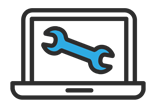Why Is My Chromebook Slow?
The main advantages of a Chromebook are its simplicity and speedy operating system that boots up quickly and allows you to be productive. Although a Chromebook with good specs should stay in good working order, there will come a time when it may slow down.
The good news is that you can do some simple things to speed up your Chromebook that don’t require a technician.
This guide will look at the factors that affect your Chromebook speed and take you through simple steps to resolve the issues.
What makes my Chromebook slow?
Over time your Chromebook will become cluttered with apps that increase the strain put on the operating system. It can lead to your Chromebook becoming slow to respond at start-up and during use.
You may notice a lag caused by high memory usage when loading, which can be very frustrating. You can do a few things to improve your Chromebook’s performance.
8 Quick Fixes to Speed up Your Chromebook
I suggest that you work through these fixes to eliminate any potential problems and fix any issues slowing up your Chromebook.
- Update Your Chromebook
It is always worth starting with a check that you have completed all the updates available for your Chromebook. You may find they have updated automatically, but it is time to complete them if not.
You can check for updates by going to settings and clicking on “About Chrome OS”. Next, click “Check for Updates”. If there is an update available, you will be able to download it and restart your Chromebook for it to be effective.
If you see no updates available, you can be confident that all the latest updates have been downloaded. This is important as updates contain tweaks and security revisions that can improve the performance of your computer.
Once you have completed all the updates or found that there are none available, you can move on to the next step.
- Clear Your Hard Drive
Once your RAM becomes filled with data, it will prevent your Chromebook from operating at its full performance. Since the Chrome browser is a central feature of the Chromebook, it makes sense to optimize your experience.
Unlike Windows or Mac operating systems, Chromebooks are designed to store data in “the cloud”. The internal hard drive storage will not be sufficient to store your files and folders, so you should use Google Drive to keep your Chromebook working fast and efficiently.
- Clean up your extensions
Extensions are the small sets of software that run in your Chrome Browser. You may use things like Grammarly as part of your workflow.
Over time, extensions can cause issues as they are outdated or have developed faults. Clearing out any extensions that have become unsupported or cannot be updated is a great way to solve problems.
In Chrome, you can select “Extensions” to remove any you no longer use or suspect may be slowing you down. You may even be able to isolate the root of a problem by turning all the extensions off and using them one by one until you spot the culprit.
- Remove Unused Apps
Chromebooks use Linux and Google Play store to allow you to access a wide variety of games and Apps. Unfortunately, they use up a great deal of performance, so it is worth checking whether you can delete any.
Some apps run in the background, which can considerably slow down your Chromebook while attempting to do other things. Background running is often necessary with social media apps that operate in real-time to provide you with notifications, but if you have any apps that you don’t use, it is best to get rid of them.
Although apps that are not open do not use your system resources, they do use local storage.
In the Chrome OS settings, you will find a new App manager. It is good to review all your apps here to see if any old ones can be deleted.
- Try One Tab
One Tab is a popular extension that promises to boost performance. It works by reducing the clutter of Chrome tabs and, therefore, decreasing the number of RAM-driven processes.
It may save you up to 95% of RAM by compressing all your opened tabs into a single list where you restore them as you need them. They stay dormant until you need them, thereby reducing the RAM used unnecessarily.
One Tab is available from the Chrome Store and has over 2 million users worldwide.
- Use Google Drive for your downloads
Using Google Drive for downloads is a great little hack for Chromebook users to save memory and avoid cluttering up RAM. Simply set your Chromebook to save any downloads automatically to your Google Drive.
By saving to the Cloud, your downloads will be accessible from any device, and you will not lose them if you use a Powerwash to clean out your Chromebook.
- Powerwash
A powerwash is a last resort that can fix lag problems in your Chromebook. It is a factory reset that will wipe your device completely clean, and it should make it as good as new if you have no hardware issues.
The obvious downside is that it will erase all of your locally stored files, so it is crucial to carry out a backup to the Cloud before you begin. You will be halfway there if you have already started saving your downloads, files, and folders to Google Drive.
You will find Powerwash in “settings” under the “Advanced” tab. Go to “Reset settings” and click on Powerwash to begin.
You will be expected to restart your Chromebook, and once it has rebooted, you will see that your device has reset. Hopefully, you will find that it now operates as new and is back to its optimal speed.
It is essential to carry out the previous steps before doing a powerwash as any faulty extensions will be returned when you sign in, which will continue to cause you problems. However, if you still find it sluggish, you may need to seek further help as you may have a hardware issue.
Is it time for a new Chromebook?
Once you have hygiened your Chromebook, you will hopefully find that your device is working faster and with less lag. However, if you find that your Chromebook is still not performing as you expect, you may need to consider whether it is time to invest in a new one despite all your efforts.
All computing devices have a shelf life where they no longer work at their prime. You can check whether your device may be past its best by going to the auto-update policy. Once your device is too old to get support from Google and will no longer receive updates, it may be time to get a new one.
Want To Buy Some New Tech?
Leave your details, and we will call you.
Take a look at our services
Get in touch.
We’d love to hear from you.
Give us a call, send an email or drop us a note and we’ll call you back.

